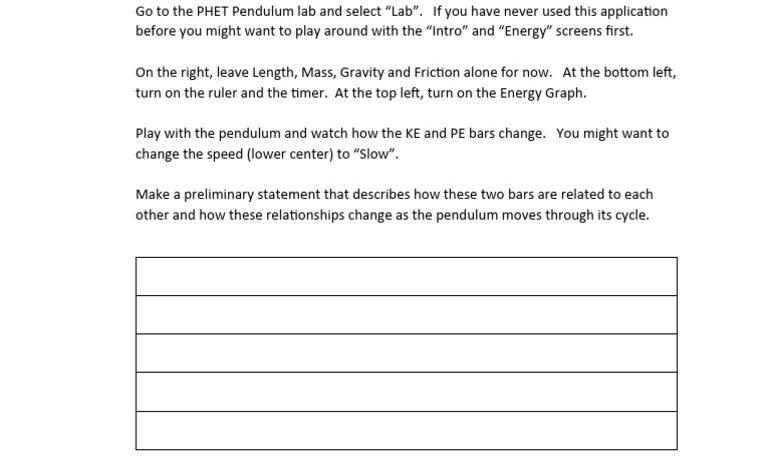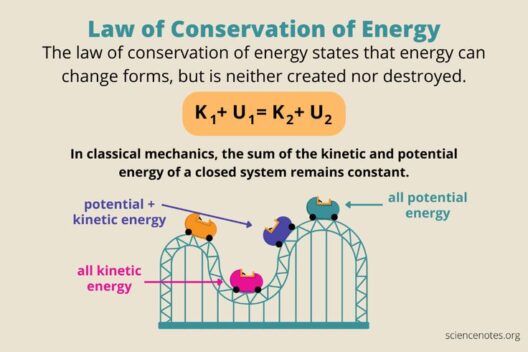Understanding energy conservation is fundamental in physics, notably in systems that oscillate such as pendulums. This fascinating phenomenon revolves around the principle that energy can transform from one form to another without loss in a closed system. In the context of pendulum nail experiments, it is pivotal to recognize how energy is conserved throughout the motions of the pendulum. This exploration provides not only insights into physical principles but also invites a reevaluation of how we interpret motion and energy in our daily lives.
To begin, let us clarify what a pendulum nail experiment entails. This experiment typically involves a pendulum apparatus, where an object—often a mass—is suspended by a string or rod from a fixed point, allowing it to swing freely. The primary focus of this experiment is to observe the energy transformations that occur during its oscillation. A pendulum undergoes various energy conversions: kinetic energy when it swings at maximum velocity and potential energy at its peaks where it momentarily halts before reversing direction.
In assessing the conservation of energy in these experiments, several key indicators suggest whether energy is conserved. The first and foremost indicator is the amplitude of the pendulum’s swing. Initially, as the pendulum is raised and released, it has maximum potential energy. By observing whether the pendulum reaches the same height on subsequent swings, one can infer energy conservation. If the pendulum consistently swings to the same height, energy is conserved. However, should the heights progressively decrease, one must consider external forces—such as air resistance and friction at the pivot point—that dissipate energy, revealing the intricacies of real-world energy dynamics.
Furthermore, the use of a stopwatch can play an essential role in documenting the frequency and period of the pendulum’s oscillation. The rate at which the pendulum completes full swings can help validate energy conservation. In a frictionless environment, the period of a pendulum should remain constant regardless of the amplitude, corroborating the theory of energy conservation. Alterations in the period may suggest the influence of external forces or imperfections in the apparatus, highlighting deviations from the ideal conditions required for perfect energy conservation.
Another intriguing approach is to analyze the oscillation data collected during the experiment. By plotting the pendulum’s height against time, one can derive graphs depicting the transformation between kinetic and potential energy. Such graphical representations become powerful tools to visualize energy dynamics; a smooth sinusoidal wave would illustrate consistent energy conservation. In contrast, irregularities or dampening effects in the graph may indicate energy losses due to non-conservative forces, deepening the understanding of energy interactions.
Acoustic observations also offer unique insights during the pendulum’s motion. The sounds emitted during each swing can indicate energy loss. If one hears a noticeable reduction in sound as the pendulum swings, it may signal energy absorption by surrounding materials, presenting another dimension to explore. The relationship between mechanical energy and sound energy introduces broader interpretations regarding energy conservation and loss.
Utilizing variations in mass can further illuminate the principles behind energy conservation in pendulum experiments. By changing the mass hung from the pendulum, one can explore how this affects the swinging behavior while keeping the length of the pendulum constant. An intriguing observation is how varying mass influences the kinetic energy at the lowest point of the swing and potential energy at the highest. Ideally, if energy is conserved, different masses should not alter the height to which the pendulum rises subsequent to release. Diversifying this parameter aligns with a broader inquiry into how intrinsic properties of materials interact with energy conservation principles.
Moreover, consider the incorporation of technology into these experiments. Sensors that measure angle, velocity, and timing can provide precise data, along with software that analyzes the results. Such advancements allow researchers and students alike to engage more deeply with the concepts of energy conservation. Data analytics can reveal patterns that imply conservation—or lack thereof—in ways that manual observations may overlook.
Crucially, the idea of energy conservation in pendulum nail experiments serves as an allegory for broader environmental principles. The way a pendulum operates mirrors the cyclical nature of energy in ecosystems. Just as energy within the pendulum system must adhere to conservation laws, ecological systems rediscover balance continually, reemphasizing the significance of sustainability and efficient energy use in our environments.
Reflecting on these experiments invites curiosity about one’s own interaction with energy. Are there areas in daily life where energy conservation principles can be applied? The inherent beauty of learning through experiments lies not just in theoretical applications but also in fostering an inquisitive mindset toward the world around you—spotting energy transitions in everyday actions, from the humble swing of a child in a park to the larger, complex interactions of our planet’s energy systems.
In encapsulation, the pendulum nail experiment serves as more than a mere physics demonstration. It embodies profound principles that can reshape our understanding of energy. By meticulously observing the behaviors, conducting thorough analyses, and contemplating the implications of energy conservation, one nurtures a deeper connection not only to physical principles but to the broader environmental narrative. Thus, every swing of the pendulum becomes a reflection—an opportunity to embrace the tenets of sustainability and efficiency in our lives.







